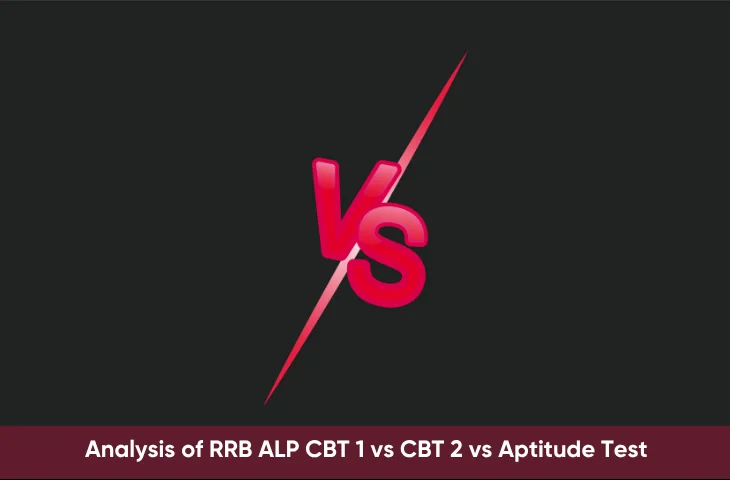RRB ALP CBT 1 vs CBT 2: The Railway Recruitment Board (RRB) Assistant Loco Pilot (ALP) examination is a multi-stage process designed to assess candidates’ aptitude, technical knowledge, and practical skills. Understanding the distinctions between each stage, CBT-1, CBT-2, and the Aptitude Test—is crucial for effective preparation. This article provides a comprehensive analysis of these stages, focusing on the differences and similarities, to guide aspirants through the selection process.
RRB ALP CBT-1 – The Screening Stage
The RRB ALP Exam Pattern for CBT 1 are given below:
- Total Questions: 75
- Duration: 60 minutes
- Marking Scheme: 1 mark for each correct answer
- Negative Marking: 1/3 mark deducted for each incorrect answer
The important subjects covered are as follows:
- Mathematics: Number System, BODMAS, Decimals, Fractions, LCM, HCF, Ratio and Proportion, Percentages, Time and Work, Time and Distance, Simple and Compound Interest, Profit and Loss, Algebra, Geometry, Trigonometry, Elementary Statistics
- General Intelligence & Reasoning: Analogies, Alphabetical and Number Series, Coding and Decoding, Mathematical operations, Relationships, Syllogism, Jumbling, Venn Diagram, Data Interpretation and Sufficiency, Conclusions and Decision Making, Similarities and Differences, Analytical reasoning, Classification, Directions, Statement – Arguments and Assumptions
- General Science: Physics, Chemistry, and Life Sciences of 10th standard level
- General Awareness & Current Affairs: Current events, Indian history, geography, culture, economics, and politics
The key features of RRB ALP CBT 1 Exam are as follows:
- Objective Type Questions: Multiple-choice format
- Educational Level: Aligned with the educational qualification prescribed for the post
- Purpose: To shortlist candidates for the next stage
RRB ALP CBT 2 – The Technical Evaluation
The exam structure of RRB ALP CBT 2 is slightly different from CBT 1. Check out the details below:
- Part A: General Studies and Technical Abilities
- Subjects: Mathematics, General Intelligence & Reasoning, General Science, and Basic Science and Engineering
- Total Questions: 100
- Duration: 90 minutes
- Part B: Trade/Subject-Specific Test
- Subjects: Relevant to the candidate’s chosen trade (e.g., Electrical, Mechanical, Electronics)
- Total Questions: 75
- Duration: 60 minutes
The important subjects in the RRB ALP Syllabus for Part A and B are given below:
| Part | Subject | Topic/Details |
| Part A | Mathematics | Advanced topics building upon CBT-1 concepts |
| General Intelligence & Reasoning | More complex problems requiring deeper analytical skills | |
| General Science | Higher-level questions beyond the 10th standard | |
| Basic Science and Engineering | Topics related to the candidate’s trade | |
| Part B | Trade-Specific Knowledge | In-depth questions pertaining to the chosen trade |
| Electrical | Basic Electricity, Work, Power, and Energy, Heat and Temperature, Units, Speed and Velocity, Engineering Drawing, Mass, Weight, and Density, IT Literacy, Levers and Simple Machines, Environment Education, Occupational Safety and Health, Measurements | |
| Mechanical | Thermodynamics, IC Engines, Heat Transfers, Machine Design, System Theory, Power Plant Turbines | |
| Electronics | Digital Electronics, Communication Systems, Microprocessors, Electrical and Electronic Measurements |
The key features are as follows:
- Objective Type Questions: Multiple-choice format
- Purpose: To assess technical knowledge and trade-specific skills
- Eligibility: Candidates must qualify CBT-1 to appear for CBT-2
RRB ALP Aptitude Test – The Final Assessment
The main purpose of the RRB ALP Aptitude Test is to assess the candidate’s suitability for the role of Assistant Loco Pilot. Only candidates who qualify CBT-2 are eligible for the Aptitude Test. The main components include:
- Psychometric Test: Evaluates mental and psychological attributes
- Motor Skills Test: Assesses hand-eye coordination and reaction time
- Vision Test: Checks visual acuity and color perception
- Hearing Test: Evaluates auditory capabilities
Some of the features of the aptitude test are given below:
- Non-Objective Format: Practical and physical assessments
- Purpose: To determine the candidate’s ability to perform the duties of an Assistant Loco Pilot
- Conducted By: Railway Recruitment Board
A Comparative Overview of RRB ALP CBT-1 and CBT-2
We have given below a comparative overview of the RRB ALP CBT 1 and CBT 2 exam. Check out the differences:
| Feature | CBT 1 | CBT 2 |
| Total Questions | 75 | 175 (100 in Part A + 75 in Part B) |
| Duration | 60 minutes | 150 minutes (90 minutes for Part A + 60 minutes for Part B) |
| Subjects Covered | Mathematics, Reasoning, General Science, General Awareness | Mathematics, Reasoning, General Science, Basic Science and Engineering, Trade-Specific Knowledge |
| Objective Type | Yes | Yes |
| Purpose | Screening for next stage | Technical evaluation and trade assessment |
Key Points of RRB ALP CBT 1 and CBT 2
The key points summarizing the article are discussed below for the candidates:
- CBT-1: Serves as a screening test focusing on general aptitude and basic knowledge.
- CBT-2: Assesses technical skills and trade-specific knowledge, with a higher level of difficulty.
- Aptitude Test: Evaluates practical abilities and psychological suitability for the role.
- Preparation Strategy: Aspirants should focus on strengthening both general aptitude and technical knowledge, along with practical skills.
The RRB ALP selection process is designed to comprehensively assess a candidate’s capabilities, from general aptitude to technical expertise and practical skills. Understanding the structure and requirements of each stage – CBT-1, CBT-2, and the Aptitude Test, is essential for effective preparation. By focusing on each stage’s specific demands and strategically preparing for them, candidates can enhance their chances of success in securing the Assistant Loco Pilot position.
FAQs
CBT 1 is the first stage of the selection process, focusing on general aptitude, reasoning, mathematics, and general science.
CBT 2 is the second stage, covering higher difficulty levels and trade-specific knowledge, along with more advanced reasoning and technical questions.
CBT 1 typically has simpler questions with a moderate marking scheme to shortlist candidates.
CBT 2 has a higher weightage for technical/trade-specific knowledge and carries more challenging questions.
No, CBT 1 primarily focuses on general subjects. Trade-specific knowledge is tested in CBT 2 (Part B).
For CBT 1, focus on basics of mathematics, reasoning, and general science.
For CBT 2, practice advanced topics, complex reasoning, and thorough trade-specific knowledge based on your chosen discipline (Electrical, Mechanical, or Electronics).

Hello! This is Arijit Dutta. I am a skilled Content Writer at Oliveboard with nearly 3+ years of experience in crafting engaging, informative, and exam-focused content for the Railways Domain. With a strong command of language and a keen understanding of learner needs, I contribute significantly to Oliveboard’s mission of delivering high-quality educational resources. Passionate about clear communication and continuous learning, I consistently create content that helps government job aspirants achieve their goals. Outside of work, I enjoy playing cricket and listening to music, which helps me stay balanced and creative in my professional journey.
